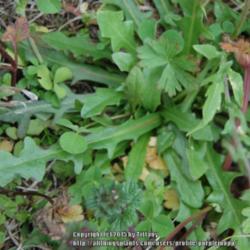
Shepherd's purse (Capsella bursa-pastoris) and several similar wild mustard cousins grow as cool-season annuals throughout North America. Seedlings are hardy to 0 degrees F, and often begin flowering at a young age. Triangular seedpods quickly develop. Left uncontrolled, one plant may shed 40,000 seeds. Young plants are easy to pull from moist soil, and they make good compost fodder, provided they are not holding mature seeds. They also can be cultivated into submission with a sharp hoe.
Weed Control TechniquesPulling. Most young weeds can be pulled from the soil. They will slide out most easily if you pull them when the soil is wet. Getting the root up is crucial, so think of the main stem as the root's handle, and grasp it as close to the soil line as you can. If you find that the weeds are breaking off at the crown as you pull, slip a kitchen fork, dandelion weeder, or similar tool under the weed, and pry and twist as you pull it up. Weeds that have taproots, such as dandelion and plantain, usually must be pried out. A flexible pair of waterproof gloves will keep your hands comfortable as you weed, and it's good to have a nice sitting pad, too. Let pulled weeds bake in the sun for a day or so before composting them. If pulled weeds are holding mature seeds, compost them separately in a hot, moist pile before using this compost in the garden.
Cultivating. Slicing and dicing weeds with a hoe works best when the soil is relatively dry, and the same goes for cultivating with a tiller. With their tops mangled and roots cut, most young weeds will quickly shrivel up and die. Be careful to cultivate only the top inch or two of soil or you may injure nearby garden plant roots and drag new weed seeds to the surface. A sharp hoe works much better than a dull one, so refresh the edge on your hoe with a steel file between weeding sessions. After using either a hoe or tiller to cultivate weeds, go back the next day to nip out any survivors. When battling perennial weeds, you can weaken the plants by chopping them down with a sharp hoe, but it's best to combine hoeing with digging to achieve good control. Never use a tiller in soil that is infested with bindweed, quackgrass, or other weeds that regrow from small pieces of root; they are easily spread by rototilling.
Photo courtesy of Jenna Antonino DiMare, National Gardening Association